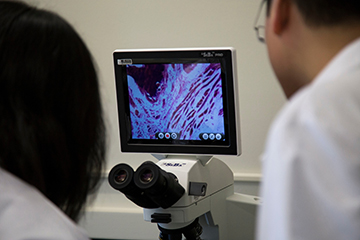Engineering for a Sustainable Future

ESE chair Yanna Liang cites climate change, resource depletion and natural disaster frequency as factors driving the demand for environmental engineers. (Photos by Patrick Dodson)
ALBANY, N.Y. (April 15, 2019) — In a time of rapid technological advancement, a changing climate and growing global population, UAlbany’s College of Nanotechnology, Science, and Engineering (CNSE) is embarking on a new degree program designed to educate the next generation of environmental engineers to tackle these issues from a sustainable perspective.
The New York State Education Department (NYSED) has approved the college’s Bachelor of Science degree program in Environmental and Sustainable Engineering, and UAlbany is accepting applications immediately.
Environmental and Sustainable Engineering (ESE) is a discipline that builds on knowledge, discovery and information from math and basic sciences to solve critical environmental problems on national and global scales. Among the many issues that environmental engineers endeavor to resolve are air pollution and prevention, water and wastewater treatment and reuse, water resource management, soil and groundwater clean-up, and hazardous waste remediation.
The ESE undergraduate degree offered by UAlbany is the first to be offered at a public university in the United States. The University started this process by creating a department within CEAS uniquely dedicated to both environmental and sustainable engineering, rather than as simply a second option within a preexisting civil engineering program.
“Our innovation is to recognize, prepare for and take advantage of the coming rapid, enormous growth in these areas driven by national and global needs, and the recognition among students that the engineering solutions to be developed in this program and by its graduates are required to make lasting changes to improve the human condition across the planet,” said CEAS Dean Kim L. Boyer.
The degree program further distinguishes itself from conventional environmental engineering by having a serious emphasis, long-term vision and deep commitment to sustainable solutions.
“The program is designed to address these challenging environmental issues, provide sustainable designs for natural and engineered environments, and promote sustainability in all areas related to human health and the world in which we live,” continued Boyer.
“As we face climate change, resource depletion and increased frequency of natural disasters, we need environmental engineers more than ever before,” said Professor and ESE Chair Yanna Liang. “The need is both local and global: While the world grapples with the long-term impact of climate change on distressed communities, New York continues to contend with high wastewater treatment costs and numerous Superfund sites that require substantial cleanup of polluted soil and groundwater by either well-known or emerging contaminants.”
These needs also are reflected by job growth predictions. According to the New York State Department of Labor, environmental engineers can expect job market growth exceeding 20 percent across the state, and greater than 12 percent nationally in the next five years. Growth projections also are robust for the next decade, given the challenges of global warming, infrastructure resilience and energy management.
The mission of this program also fits within the University’s core priorities of student success, research excellence, globalization, public engagement and community outreach, and diversity and inclusion. The program will seek to collaborate with individuals and organizations from different countries and regions to provide sustainable solutions to the environmental problems they face. Environmental engineering also is one of the relatively few engineering disciplines that have traditionally attracted as many women as men to the field. In 2015, 49.7 percent of the bachelor’s degrees awarded in the field went to women.
Students enrolling in ESE will be equipped with a strong foundation in this broad discipline, state-of-the-art technologies for solving environmental problems using sustainable approaches, and skills for lifelong learning. Graduates of the program will embark on careers that seek to solve the challenging problems facing the environment, human health and society, and that actively pursue sustainability through critical thinking and innovative solutions.
The ESE program also will collaborate with other schools and colleges at UAlbany, including the College of Arts and Sciences’ Department of Atmospheric and Environmental Sciences (DEAS), and Environmental Health Sciences of the School of Public Health.
The ESE department will eventually be housed, along with DEAS, in the state-of-the-art Emerging Technology and Entrepreneurship Complex (ETEC), under construction at the Harriman State Office Campus.
Created in 2015, CEAS was designed to provide the Capital Region’s first public option for computer engineering, and to create opportunities for students and to drive regional economic development.
The new programs also are significant as UAlbany continues to move forward with plans to renovate the former Schuyler Building to serve as a new home for the College.
UAlbany is seeking $60 million in capital funding to support the renovation of the North Lake Avenue facility. The renovation also will broaden UAlbany’s downtown footprint and make CEAS a hub for public partnerships and significant public engagement opportunities, including use of the facility’s 1,000-seat auditorium, “maker-tinker space” for unstructured learning, student entrepreneurs and capstone design projects, and programs for local K-12 schools.



